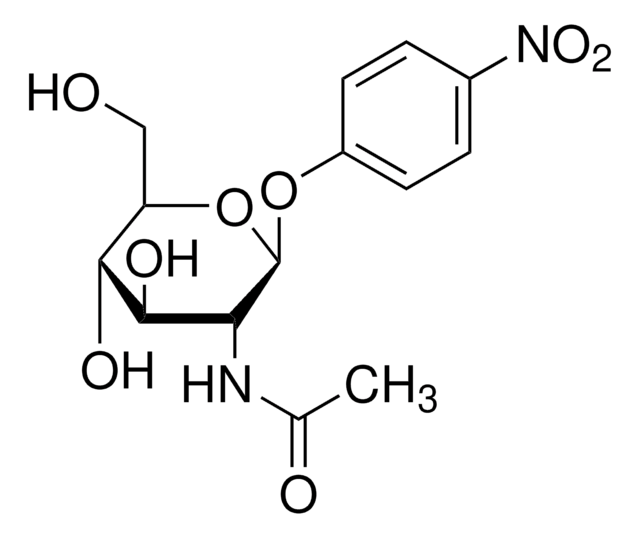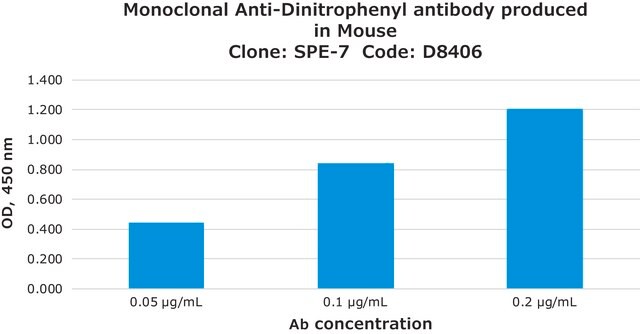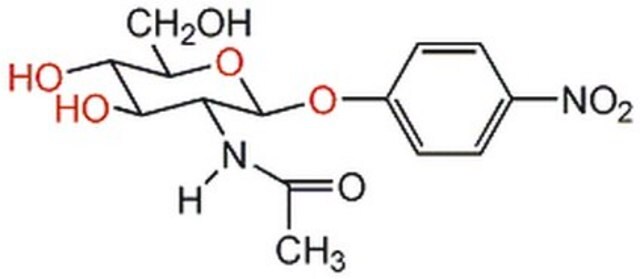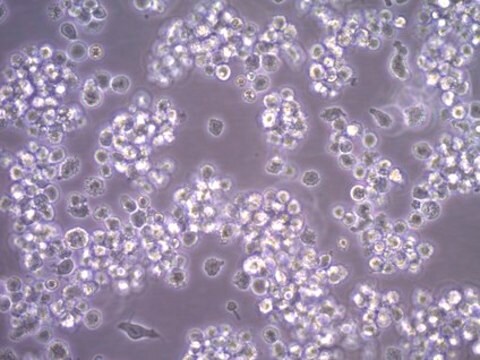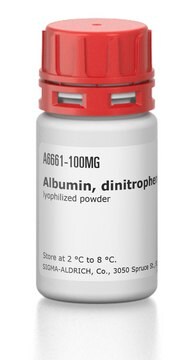IMM001
Mast Cell Degranulation Assay Kit
The Mast Cell Degranulation Assay Kit provides a quick, efficient & sensitive system for evaluation of tryptase activity in culture supernatants, cell lysates or other tryptase-containing samples.
Sinonimo/i:
Live mast cell tryptase assay
Autenticatiper visualizzare i prezzi riservati alla tua organizzazione & contrattuali
About This Item
Codice UNSPSC:
12352207
eCl@ss:
32161000
NACRES:
NA.32
Prodotti consigliati
Produttore/marchio commerciale
Chemicon®
tecniche
activity assay: suitable
cell based assay: suitable
Condizioni di spedizione
dry ice
Descrizione generale
Introduction
Degranulation, the secretion of cytoplasmic granules, is a key step in the inflammatory response of leukocytes (e.g. basophils, neutrophils, eosinophils, and mast cells). In addition to histamine, these secretory granules contain many proinflammatory mediators including heparin, cytokines, chemokines, and many proteases (Hallgren, 2001). Tryptase, a tetrameric serine proteinase, has emerged as the major component of mast cell granules, comprising up to 20% of the total protein of mast cells derived from lung, colon and skin tissue (He, 2004; He, 1998; Schwartz, 1986). Because it is stored almost exclusively in mast cells, tryptase is a popular indicator of mast cell activation and a target for therapeutic intervention in allergic diseases. The Chemicon Mast Cell Degranulation Assay Kit provides a quick, efficient and sensitive system for evaluation of tryptase activity in cell lysates, supernatants or for inhibitor screening.
Test Principle
Chemicon′s Mast Cell Degranulation Assay Kit provides a simple and convenient means for assaying tryptase activity. The assay is based on spectophotometric detection of the chromophore p-nitroaniline (pNA) after cleavage from the labeled substrate tosyl-gly-pro-lys-pNA. The free pNA can then be quantified using a spectrophotometer or a microtiter plate reader at 405 nm. A pNA Standard is provided as a comparison control.
Calcium Ionophore A23187 (Calcimycin) is included in the kit for degranulation induction of samples. Calcimycin has been a well-documented inducer of tryptase release from human mast cells (2,3).
A tryptase inhibitor, protamine, is included as a test inhibitor for screening purposes. Protamine is a potent heparin antagonist that competitively binds heparin, an essential stabilizing factor of mast cell tryptase (Hallgren, 2001; Schwartz, 1986). Protamine has been shown to inhibit both human and mouse tryptase (Hallgren, 2001). The kit′s Assay Buffer contains heparin for tryptase stabilization.
Degranulation, the secretion of cytoplasmic granules, is a key step in the inflammatory response of leukocytes (e.g. basophils, neutrophils, eosinophils, and mast cells). In addition to histamine, these secretory granules contain many proinflammatory mediators including heparin, cytokines, chemokines, and many proteases (Hallgren, 2001). Tryptase, a tetrameric serine proteinase, has emerged as the major component of mast cell granules, comprising up to 20% of the total protein of mast cells derived from lung, colon and skin tissue (He, 2004; He, 1998; Schwartz, 1986). Because it is stored almost exclusively in mast cells, tryptase is a popular indicator of mast cell activation and a target for therapeutic intervention in allergic diseases. The Chemicon Mast Cell Degranulation Assay Kit provides a quick, efficient and sensitive system for evaluation of tryptase activity in cell lysates, supernatants or for inhibitor screening.
Test Principle
Chemicon′s Mast Cell Degranulation Assay Kit provides a simple and convenient means for assaying tryptase activity. The assay is based on spectophotometric detection of the chromophore p-nitroaniline (pNA) after cleavage from the labeled substrate tosyl-gly-pro-lys-pNA. The free pNA can then be quantified using a spectrophotometer or a microtiter plate reader at 405 nm. A pNA Standard is provided as a comparison control.
Calcium Ionophore A23187 (Calcimycin) is included in the kit for degranulation induction of samples. Calcimycin has been a well-documented inducer of tryptase release from human mast cells (2,3).
A tryptase inhibitor, protamine, is included as a test inhibitor for screening purposes. Protamine is a potent heparin antagonist that competitively binds heparin, an essential stabilizing factor of mast cell tryptase (Hallgren, 2001; Schwartz, 1986). Protamine has been shown to inhibit both human and mouse tryptase (Hallgren, 2001). The kit′s Assay Buffer contains heparin for tryptase stabilization.
Applicazioni
The Mast Cell Degranulation Assay Kit provides a quick, efficient & sensitive system for evaluation of tryptase activity in culture supernatants, cell lysates or other tryptase-containing samples.
The Mast Cell Degranulation Assay Kit provides a quick, efficient and sensitive system for evaluation of tryptase activity in culture supernatants, cell lysates or other tryptase-containing samples. Testing of purified tryptase enzyme, in vitro inhibitor screening and the study of cell degranulation can also be performed with this assay.
The Chemicon Mast Cell Degranulation Assay Kit is intended for research use only, and not for diagnostic or therapeutic applications.
The Chemicon Mast Cell Degranulation Assay Kit is intended for research use only, and not for diagnostic or therapeutic applications.
Componenti
Tryptase Positive Control (Part No. 2003650): 20 μL of 0.1 mg/mL solution.
5X Assay Buffer (Part No. 2003649): 20 mL containing 0.1% heparin.
Calcium Ionophore A23187 (Part No. 2003652): 100 μL of 1 mM in DMSO.
Tryptase Inhibitor (Protamine) (Part No. 2003651): 250 μL of 10 mM solution.
Tryptase Substrate (tosyl-gly-pro-lys-pNA) (Part No. 90569): 3.125 mg.
pNA Standard (Part No. 90085): 250 μL of 10 mM in DMSO.
5X Assay Buffer (Part No. 2003649): 20 mL containing 0.1% heparin.
Calcium Ionophore A23187 (Part No. 2003652): 100 μL of 1 mM in DMSO.
Tryptase Inhibitor (Protamine) (Part No. 2003651): 250 μL of 10 mM solution.
Tryptase Substrate (tosyl-gly-pro-lys-pNA) (Part No. 90569): 3.125 mg.
pNA Standard (Part No. 90085): 250 μL of 10 mM in DMSO.
Stoccaggio e stabilità
Store kit materials (as provided) at -20°C up to their expiration date. See Storage of Reagents for component specific instructions.
Storage of Reagents
1. Tryptase Positive Control: Thaw vial at 2-8°C. Aliquot and store at -20°C up to the vial′s expiration date. Avoid multiple freeze/thaw cycles.
2. 5X Assay Buffer: Dilute the 5X Assay Buffer with deionized water. Stir to homogeneity and store at 2-8°C up to its expiration date.
3. Calcium Ionophore A23187: Thaw vial at 2-8°C. Aliquot and store at -20°C up to the vial′s expiration date. Avoid multiple freeze/thaw cycles.
4. Tryptase Inhibitor: Thaw vial at 2-8°C. Aliquot and store at -20°C up to the vial′s expiration date. Avoid multiple freeze/thaw cycles.
5. Tryptase Substrate: Reconstitute with 2 mL of 1X Assay Buffer (2.5 mM stock solution). Aliquot and store at -20°C up to 3 months. Avoid multiple freeze/thaw cycles.
6. pNA Standard: Thaw vial at 2-8°C. Aliquot and store at -20°C up to the vial′s expiration date. Avoid multiple freeze/thaw cycles.
Note: Positive Control, Substrate, pNA Standard, and Calcium Ionophore are light sensitive; amber vials or equivalent should be used. Keep materials away from light as much as possible and during storage.
Storage of Reagents
1. Tryptase Positive Control: Thaw vial at 2-8°C. Aliquot and store at -20°C up to the vial′s expiration date. Avoid multiple freeze/thaw cycles.
2. 5X Assay Buffer: Dilute the 5X Assay Buffer with deionized water. Stir to homogeneity and store at 2-8°C up to its expiration date.
3. Calcium Ionophore A23187: Thaw vial at 2-8°C. Aliquot and store at -20°C up to the vial′s expiration date. Avoid multiple freeze/thaw cycles.
4. Tryptase Inhibitor: Thaw vial at 2-8°C. Aliquot and store at -20°C up to the vial′s expiration date. Avoid multiple freeze/thaw cycles.
5. Tryptase Substrate: Reconstitute with 2 mL of 1X Assay Buffer (2.5 mM stock solution). Aliquot and store at -20°C up to 3 months. Avoid multiple freeze/thaw cycles.
6. pNA Standard: Thaw vial at 2-8°C. Aliquot and store at -20°C up to the vial′s expiration date. Avoid multiple freeze/thaw cycles.
Note: Positive Control, Substrate, pNA Standard, and Calcium Ionophore are light sensitive; amber vials or equivalent should be used. Keep materials away from light as much as possible and during storage.
Note legali
CHEMICON is a registered trademark of Merck KGaA, Darmstadt, Germany
Esclusione di responsabilità
Unless otherwise stated in our catalog or other company documentation accompanying the product(s), our products are intended for research use only and are not to be used for any other purpose, which includes but is not limited to, unauthorized commercial uses, in vitro diagnostic uses, ex vivo or in vivo therapeutic uses or any type of consumption or application to humans or animals.
Codice della classe di stoccaggio
10 - Combustible liquids
Certificati d'analisi (COA)
Cerca il Certificati d'analisi (COA) digitando il numero di lotto/batch corrispondente. I numeri di lotto o di batch sono stampati sull'etichetta dei prodotti dopo la parola ‘Lotto’ o ‘Batch’.
Possiedi già questo prodotto?
I documenti relativi ai prodotti acquistati recentemente sono disponibili nell’Archivio dei documenti.
Tsong-Min Chang et al.
Molecules (Basel, Switzerland), 26(13) (2021-07-03)
Mast cells play a crucial role in the pathogenesis of type 1 allergic reactions by binding to IgE and allergen complexes and initiating the degranulation process, releasing pro-inflammatory mediators. Recently, research has focused on finding a stable and effective anti-allergy
Simon Gebremeskel et al.
Frontiers in immunology, 12, 650331-650331 (2021-03-30)
Coronavirus disease 2019 (COVID-19) caused by SARS-CoV-2 infection represents a global health crisis. Immune cell activation via pattern recognition receptors has been implicated as a driver of the hyperinflammatory response seen in COVID-19. However, our understanding of the specific immune
Shaun A Summers et al.
Journal of the American Society of Nephrology : JASN, 22(12), 2226-2236 (2011-10-25)
Leukocyte recruitment contributes to acute kidney injury (AKI), but the mechanisms by which leukocytes promote injury are not completely understood. The degranulation of mast cells releases inflammatory molecules, including TNF, but whether these cells participate in the pathogenesis of AKI
IgE-mediated mast cell activation promotes inflammation and cartilage destruction in osteoarthritis.
Qian Wang et al.
eLife, 8 (2019-05-16)
Osteoarthritis is characterized by articular cartilage breakdown, and emerging evidence suggests that dysregulated innate immunity is likely involved. Here, we performed proteomic, transcriptomic, and electron microscopic analyses to demonstrate that mast cells are aberrantly activated in human and murine osteoarthritic
Katja Zschiebsch et al.
Journal of cellular and molecular medicine, 23(2), 985-1000 (2018-11-20)
GTP cyclohydrolase (GCH1) governs de novo synthesis of the enzyme cofactor, tetrahydrobiopterin (BH4), which is essential for biogenic amine production, bioactive lipid metabolism and redox coupling of nitric oxide synthases. Overproduction of BH4 via upregulation of GCH1 in sensory neurons
Il team dei nostri ricercatori vanta grande esperienza in tutte le aree della ricerca quali Life Science, scienza dei materiali, sintesi chimica, cromatografia, discipline analitiche, ecc..
Contatta l'Assistenza Tecnica.
